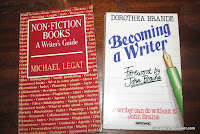Pondering knitting some soft toys for young friends, one of them commented that her older brother, who is about to turn 18, is a great fan of penguins. They thought he would appreciate a knitted toy penguin for his birthday.
I was a bit dubious, but then we spotted the mini penguins in Sachiyo Ishii's book 'Tiny Toys to Make'. It didn't look too difficult, so I thought I'd try one and see how it looked. The book recommends 2.75mm needles and double knitting yarn, but I prefer 3mm ones; I knit rather tightly anyway.
The book shows one penguin in grey and white, one in blue and white. I was pretty sure penguins were black and white, so I set to work with black yarn, left over from another project. The pattern only takes very small amounts of each, and was so quick to knit that I finished it in about forty-five minutes. The head and body are made in one piece, and the feet, wings and beak are separate tiny parts. Sewing together and stuffing took another twenty minutes or so.
When I checked online later, I discovered that I was correct; penguins all seem to be black and white. Moreover, their feet are black too, not yellow as the pattern dictated. By this time I had decided to make another penguin to go with the first one, as they're so small, so for the second one I used dark grey yarn rather than black.
I then put black feet on the first one, and yellow on the second. The trickiest part was attaching the beak, which I couldn't get straight. But still, I think they're quite cute. They're too small for toys, really, so I wouldn't recommend them for a small child, but as ornaments for a fan of penguins, they're rather fun.
They don't stand up by themselves, but leaning against a wall they stay upright. A slightly out-of-focus photo demonstrates this:
If I do any more, I will have to remember to ensure that the black or grey yarn, carried behind the white in the stomach part, is a lot looser. I thought I had left it quite loose, but when I started stuffing I realised that I couldn't stretch it any further, so the penguins are both rather thinner than those in the booklet.
I was a bit dubious, but then we spotted the mini penguins in Sachiyo Ishii's book 'Tiny Toys to Make'. It didn't look too difficult, so I thought I'd try one and see how it looked. The book recommends 2.75mm needles and double knitting yarn, but I prefer 3mm ones; I knit rather tightly anyway.
The book shows one penguin in grey and white, one in blue and white. I was pretty sure penguins were black and white, so I set to work with black yarn, left over from another project. The pattern only takes very small amounts of each, and was so quick to knit that I finished it in about forty-five minutes. The head and body are made in one piece, and the feet, wings and beak are separate tiny parts. Sewing together and stuffing took another twenty minutes or so.
When I checked online later, I discovered that I was correct; penguins all seem to be black and white. Moreover, their feet are black too, not yellow as the pattern dictated. By this time I had decided to make another penguin to go with the first one, as they're so small, so for the second one I used dark grey yarn rather than black.
I then put black feet on the first one, and yellow on the second. The trickiest part was attaching the beak, which I couldn't get straight. But still, I think they're quite cute. They're too small for toys, really, so I wouldn't recommend them for a small child, but as ornaments for a fan of penguins, they're rather fun.
They don't stand up by themselves, but leaning against a wall they stay upright. A slightly out-of-focus photo demonstrates this:
If I do any more, I will have to remember to ensure that the black or grey yarn, carried behind the white in the stomach part, is a lot looser. I thought I had left it quite loose, but when I started stuffing I realised that I couldn't stretch it any further, so the penguins are both rather thinner than those in the booklet.





















